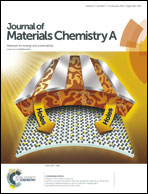Insitu gold-loaded titania photonic crystals with enhanced photocatalytic activity†
Abstract
A facile two-step method is developed to fabricate three-dimensional ordered macroporous (3DOM) gold-loaded titania (TiO2) photonic crystals with enhanced photocatalytic activities. Firstly, a mixed solution of polystyrene (PS) colloids, chloroauric acid and titanium(IV)-bis-lactato-bisammonium dihydroxide (TiBALDH) sol was co-assembled into PS/TiO2 colloidal crystal films. Subsequent calcination of the samples led to the removal of PS and transformed amorphous TiO2 into the anatase phase. The resultant 3DOM inverse TiO2 opals (i-TiO2-o) and gold-loaded i-TiO2-o (i-Au-TiO2-o) show centimeter-scale long-range ordering. Photocatalytic characterization of the i-TiO2-o and i-Au-TiO2-o showed activities two- and five-fold higher than nanocrystalline TiO2, respectively. This enhanced photocatalytic performance can be attributed to the synergetic effect of slow photons near the absorption edge of anatase TiO2 nanocrystals and chemically amplified photochemistry. The present method is much more simple and straightforward than conventional colloidal crystal templating methods. In particular, the gold nanoparticles can be in situ loaded into the inverse opal structure with controllable size and content. Furthermore, both i-TiO2-o and i-Au-TiO2-o films fabricated by this method show a highly ordered structure without overlayers in a large area, which facilitates the adsorption of target pollutants and ultimate utilization of solar energy.


 Please wait while we load your content...
Please wait while we load your content...